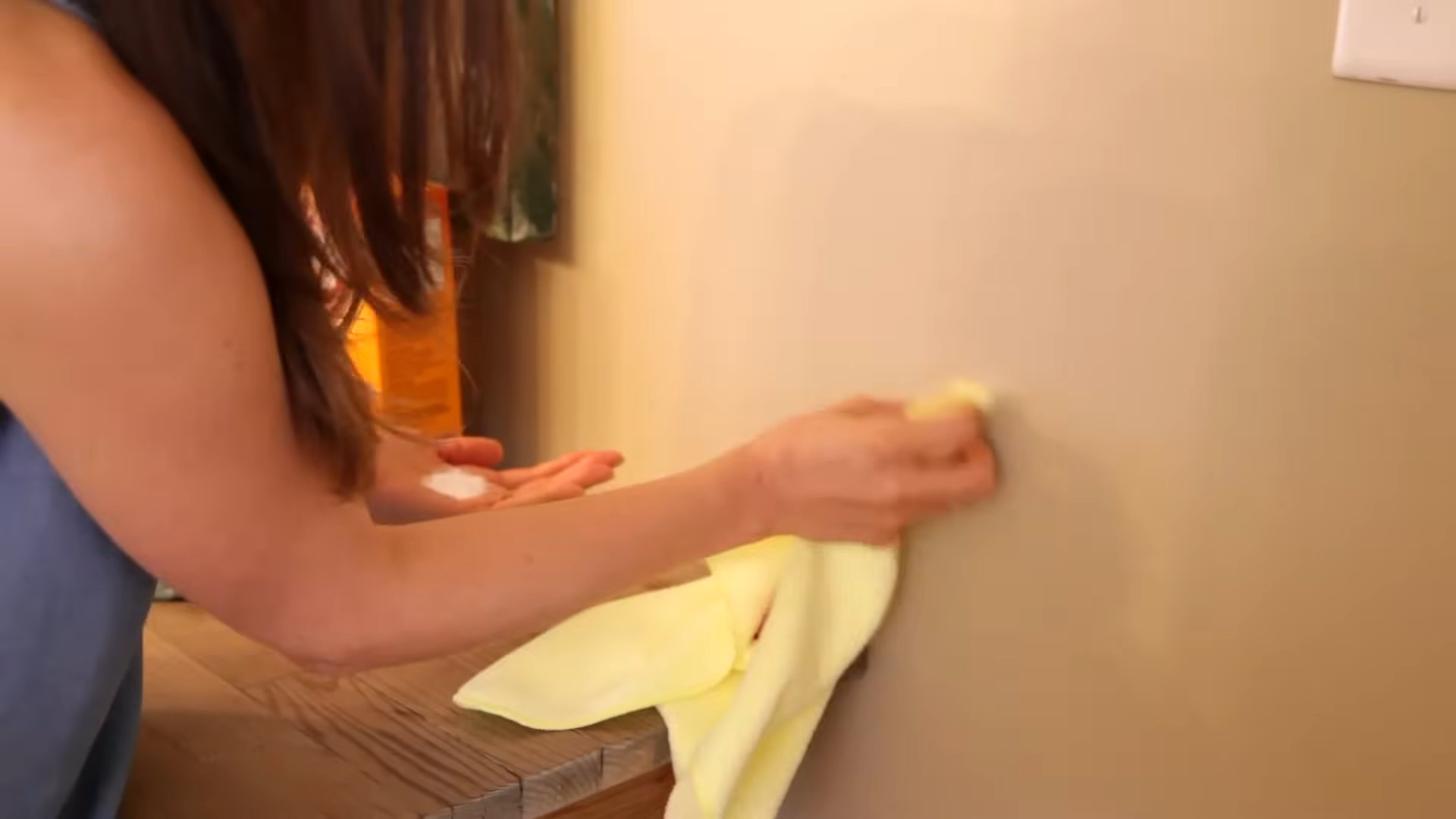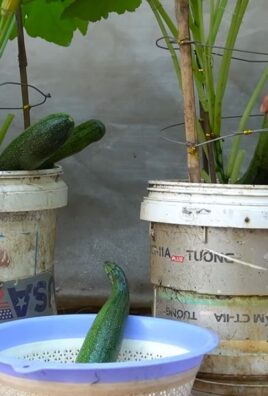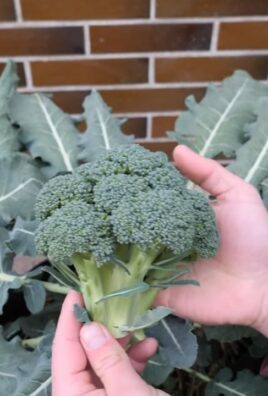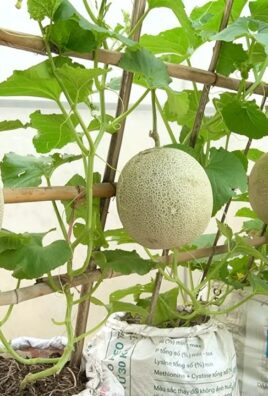Grow Asparagus Indoors Easily? Absolutely! Imagine harvesting fresh, tender asparagus spears right from your kitchen, even when the snow is falling outside. It sounds like a dream, right? Well, it’s a dream that can become a reality with a few simple tricks and a little bit of know-how. For centuries, asparagus has been prized for its delicate flavor and nutritional benefits, enjoyed by everyone from ancient Romans to modern-day foodies. But traditionally, growing asparagus meant dedicating a significant portion of your garden to a plant that takes years to mature.
But what if you don’t have a sprawling garden? Or what if you simply want to enjoy fresh asparagus year-round? That’s where the magic of indoor gardening comes in! I’m here to show you how to grow asparagus indoors easily, bypassing the limitations of outdoor space and seasonal weather. This DIY guide will provide you with step-by-step instructions, insider tips, and troubleshooting advice to ensure your indoor asparagus venture is a resounding success. Forget expensive grocery store asparagus – with a little patience and these simple techniques, you’ll be enjoying homegrown goodness in no time. Let’s get started!

Growing Asparagus Indoors: A Beginner’s Guide
Okay, so you want to grow asparagus indoors? Awesome! It might seem a little intimidating at first, but trust me, it’s totally doable. Asparagus is a perennial, meaning it can live for many years, and harvesting your own fresh spears is incredibly rewarding. This guide will walk you through everything you need to know to successfully cultivate asparagus in the comfort of your home.
Choosing the Right Asparagus Variety
First things first, let’s talk about variety. Not all asparagus varieties are created equal, especially when it comes to indoor growing. You’ll want to choose a variety that’s known for its vigor and adaptability.
* ‘Jersey Knight’: This is a popular choice for its high yield and disease resistance. It’s a male variety, which means it doesn’t produce seeds, so it puts all its energy into spear production.
* ‘Jersey Giant’: Similar to ‘Jersey Knight,’ but slightly larger spears. Also a male variety.
* ‘Purple Passion’: This variety produces beautiful purple spears that turn green when cooked. It’s known for its sweeter flavor.
* ‘Apollo’: Another reliable and productive variety that’s well-suited for home gardens.
I personally recommend starting with ‘Jersey Knight’ or ‘Jersey Giant’ if you’re a beginner. They’re pretty forgiving and tend to be readily available.
Gathering Your Supplies
Before we dive into the planting process, let’s make sure you have everything you need. Here’s a checklist:
* Asparagus Crowns: These are the root systems of the asparagus plants. You can usually find them at your local garden center or online. Look for healthy crowns that are about a year old.
* Large Containers: Asparagus needs room to grow! Choose containers that are at least 12 inches deep and 12 inches wide. The bigger, the better, really. I’d suggest something closer to 18 inches.
* Well-Draining Potting Mix: Asparagus doesn’t like soggy roots, so a well-draining potting mix is crucial. A mix of peat moss, perlite, and vermiculite works well. You can also add some compost for extra nutrients.
* Grow Lights: Asparagus needs a lot of light, especially indoors. Invest in some good quality grow lights to ensure your plants get enough energy. LED grow lights are energy-efficient and work great.
* Fertilizer: A balanced fertilizer (like 10-10-10) will help your asparagus plants thrive.
* Watering Can or Hose: For watering, obviously!
* Trowel or Shovel: For planting.
* Optional: Mulch (like straw or wood chips) to help retain moisture and suppress weeds.
Planting Your Asparagus Crowns
Okay, now for the fun part – planting!
1. Prepare Your Containers: Fill your containers with the well-draining potting mix, leaving a few inches of space at the top.
2. Create a Mound: In the center of each container, create a small mound of soil. This is where you’ll place the asparagus crown.
3. Position the Crown: Gently place the asparagus crown on top of the mound, spreading the roots out around it. Make sure the crown is positioned so that the buds (the little pointy things) are facing upwards.
4. Cover the Crown: Carefully cover the crown with soil, leaving the tips of the buds exposed. You don’t want to bury the crown too deep. About an inch or two of soil covering the main body of the crown is perfect.
5. Water Thoroughly: Water the newly planted crowns thoroughly until the water drains out of the bottom of the container. This will help settle the soil and encourage root growth.
Providing the Right Environment
Asparagus needs specific conditions to thrive indoors. Here’s what you need to keep in mind:
* Light: Asparagus needs at least 6-8 hours of direct light per day. If you don’t have a sunny window, use grow lights. Position the grow lights about 6-12 inches above the plants. I usually keep mine on a timer for 14-16 hours a day.
* Temperature: Asparagus prefers temperatures between 65-75°F (18-24°C) during the day and slightly cooler temperatures at night.
* Humidity: Asparagus likes moderate humidity. If your home is dry, you can increase humidity by using a humidifier or placing the containers on a tray filled with pebbles and water. Just make sure the bottom of the container isn’t sitting directly in the water.
* Watering: Water your asparagus plants regularly, keeping the soil consistently moist but not soggy. Check the soil moisture by sticking your finger into the soil. If the top inch feels dry, it’s time to water.
* Fertilizing: Fertilize your asparagus plants every 2-3 weeks with a balanced fertilizer. Follow the instructions on the fertilizer package.
Caring for Your Asparagus Plants
Once your asparagus plants are established, it’s important to provide ongoing care to ensure they stay healthy and productive.
* Weeding: Keep the containers free of weeds. Weeds can compete with your asparagus plants for nutrients and water.
* Mulching: Apply a layer of mulch around the base of the plants to help retain moisture and suppress weeds.
* Pruning: In the fall, after the foliage has turned yellow and died back, cut the stems back to the ground. This will help the plants conserve energy for the following growing season.
* Pest Control: Keep an eye out for pests like aphids and spider mites. If you notice any pests, treat them with insecticidal soap or neem oil.
Harvesting Your Asparagus
Patience is key when it comes to harvesting asparagus. You shouldn’t harvest any spears during the first year, as the plants need time to establish their root systems. In the second year, you can harvest a few spears, but only for a short period of time (about 2-3 weeks). In the third year and beyond, you can harvest spears for a longer period of time (about 6-8 weeks).
1. Harvesting Time: Harvest asparagus spears when they are about 6-8 inches tall and about as thick as your finger.
2. Harvesting Method: Use a sharp knife to cut the spears at ground level. Be careful not to damage the surrounding spears or the crown.
3. Harvesting Frequency: Harvest spears every day or two during the harvesting season. The more you harvest, the more the plants will produce.
Dealing with Common Problems
Even with the best care, you might encounter some problems when growing asparagus indoors. Here are some common issues and how to address them:
* Yellowing Foliage: This could be a sign of overwatering, underwatering, or nutrient deficiency. Check the soil moisture and adjust your watering schedule accordingly. Fertilize the plants with a balanced fertilizer.
* Thin Spears: This could be a sign of insufficient light or nutrient deficiency. Make sure your plants are getting enough light and fertilize them regularly.
* Pests: Aphids and spider mites are common pests that can attack asparagus plants. Treat them with insecticidal soap or neem oil.
* Disease: Asparagus rust is a fungal disease that can cause orange spots on the foliage. Improve air circulation around the plants and treat them with a fungicide if necessary.
Overwintering Your Asparagus
Asparagus needs a period of dormancy during the winter to rest and recharge. Here’s how to overwinter your asparagus plants indoors:
1. Reduce Watering: In the fall, gradually reduce watering as the foliage starts to die back.
2. Cut Back Foliage: After the foliage has turned yellow and died back, cut the stems back to the ground.
3. Cool Temperatures: Move the containers to a cool, dark location (like a basement or garage) where the temperature stays between 35-50°F (2-10°C).
4. Minimal Watering: Water the plants sparingly during the winter, just enough to keep the soil from completely drying out.
5. Bring Back Indoors: In the spring, when the weather starts to warm up, bring the containers back indoors and resume your regular watering and fertilizing schedule.
Enjoying Your Homegrown Asparagus
Congratulations! You’ve successfully grown asparagus indoors. Now it’s time to enjoy the fruits (or rather, spears) of your labor. Freshly harvested asparagus is incredibly delicious and versatile. You can steam it, grill it, roast it, or add it to salads, soups, and omelets.
Growing asparagus indoors requires a bit of effort and patience, but it’s definitely worth it. There’s nothing quite like the taste of homegrown

Conclusion
So, there you have it! Growing asparagus indoors might seem like a challenge reserved for seasoned gardeners, but with a little patience and the right approach, you can absolutely enjoy the fresh, vibrant taste of homegrown asparagus, even without a sprawling outdoor garden. This DIY trick isn’t just about saving money; it’s about connecting with your food, understanding its growth cycle, and experiencing the unique satisfaction of nurturing something from seed to plate.
Why is this a must-try? Because it offers a sustainable and rewarding way to access fresh produce year-round, regardless of your climate or living situation. Imagine the delight of adding freshly harvested asparagus spears to your spring salads, omelets, or grilled dishes, knowing you cultivated them yourself. It’s a conversation starter, a learning experience, and a delicious addition to your culinary repertoire.
But don’t stop there! Feel free to experiment with different asparagus varieties. While ‘Jersey Knight’ is a popular choice for its high yield and disease resistance, explore other options like ‘Purple Passion’ for its unique color and sweeter flavor, or ‘Millennium’ for its cold hardiness. You can also play around with different potting mixes to find what works best for your growing environment. Some gardeners prefer a blend of compost, perlite, and vermiculite, while others opt for a more soil-based mix. The key is to ensure good drainage and adequate nutrient availability.
Consider also the lighting. While a sunny south-facing window is ideal, you might need to supplement with grow lights, especially during the shorter days of winter. LED grow lights are energy-efficient and provide the full spectrum of light that asparagus needs to thrive. Experiment with different light intensities and durations to optimize growth.
And remember, patience is key. Asparagus takes time to mature, so don’t be discouraged if you don’t see immediate results. The first year is primarily about establishing a strong root system. You might only harvest a few spears in the second year, but by the third year, you’ll be rewarded with a more substantial harvest.
We wholeheartedly encourage you to try this DIY trick for growing asparagus indoors. It’s a rewarding project that brings a touch of nature into your home and provides you with a delicious and healthy food source. Once you’ve embarked on your indoor asparagus growing journey, we’d love to hear about your experiences! Share your tips, tricks, and photos in the comments below. Let’s create a community of indoor asparagus enthusiasts and learn from each other. What are you waiting for? Get your seeds, gather your supplies, and start growing your own delicious, homegrown asparagus today! This method of growing **asparagus indoors** is sure to bring you joy and fresh produce for years to come.
Frequently Asked Questions (FAQ)
What kind of container should I use for growing asparagus indoors?
The ideal container should be at least 12 inches deep and wide to accommodate the extensive root system of asparagus. A larger container is generally better, as it provides more room for the roots to grow and access nutrients. Choose a container made of plastic, terracotta, or any other durable material. Ensure that the container has drainage holes to prevent waterlogging, which can lead to root rot. You can also use grow bags, which are lightweight and breathable, promoting healthy root development.
How often should I water my indoor asparagus plants?
Water asparagus plants deeply whenever the top inch of soil feels dry to the touch. Avoid overwatering, as this can lead to root rot. During the growing season (spring and summer), you may need to water more frequently than during the dormant season (fall and winter). Check the soil moisture regularly and adjust your watering schedule accordingly. A good rule of thumb is to water thoroughly until excess water drains out of the drainage holes.
What type of soil is best for growing asparagus indoors?
Asparagus prefers well-draining soil that is rich in organic matter. A good potting mix for indoor asparagus plants should consist of a blend of compost, perlite, and vermiculite. Compost provides essential nutrients, while perlite and vermiculite improve drainage and aeration. Avoid using heavy clay soils, as they can become waterlogged and inhibit root growth. You can also amend your potting mix with bone meal or rock phosphate to provide additional phosphorus, which is essential for root development.
How much sunlight do indoor asparagus plants need?
Asparagus plants need at least six to eight hours of direct sunlight per day to thrive. A south-facing window is ideal, as it provides the most sunlight. If you don’t have access to a sunny window, you can supplement with grow lights. LED grow lights are energy-efficient and provide the full spectrum of light that asparagus needs. Position the grow lights a few inches above the plants and keep them on for 12 to 16 hours per day.
When can I start harvesting asparagus spears from my indoor plants?
It’s best to wait until the third year after planting before harvesting asparagus spears. This allows the plants to establish a strong root system and build up energy reserves. In the second year, you can harvest a few spears, but avoid harvesting too many, as this can weaken the plants. In the third year and beyond, you can harvest spears for several weeks in the spring. Harvest spears when they are about 6 to 8 inches tall and have tightly closed tips.
How do I fertilize my indoor asparagus plants?
Fertilize asparagus plants regularly during the growing season (spring and summer) with a balanced fertilizer. A fertilizer with an NPK ratio of 10-10-10 is a good choice. Follow the instructions on the fertilizer label for application rates. You can also use organic fertilizers, such as compost tea or fish emulsion. Avoid over-fertilizing, as this can burn the roots. During the dormant season (fall and winter), reduce or stop fertilizing.
How do I deal with pests and diseases on my indoor asparagus plants?
Inspect your asparagus plants regularly for pests and diseases. Common pests that can affect asparagus include aphids, spider mites, and asparagus beetles. You can control these pests with insecticidal soap or neem oil. Diseases that can affect asparagus include rust and crown rot. Prevent these diseases by providing good air circulation and avoiding overwatering. If you notice any signs of disease, remove the affected foliage and treat the plants with a fungicide.
Can I grow asparagus from seed indoors?
Yes, you can grow asparagus from seed indoors. Start seeds indoors 12 to 14 weeks before the last expected frost. Soak the seeds in water for 24 hours before planting to improve germination. Sow the seeds in a seed-starting mix and keep them moist. Once the seedlings have developed several sets of true leaves, transplant them into larger containers.
How do I overwinter my indoor asparagus plants?
Asparagus plants need a period of dormancy in the fall and winter to rest and rejuvenate. In the fall, cut back the foliage to the ground and move the plants to a cool, dark location, such as a basement or garage. Water sparingly during the dormant season, just enough to keep the soil from drying out completely. In the spring, move the plants back to a sunny location and resume regular watering and fertilizing.
What are the benefits of growing asparagus indoors?
Growing asparagus indoors allows you to enjoy fresh, homegrown asparagus year-round, regardless of your climate or living situation. It’s a sustainable and rewarding way to access fresh produce and connect with your food. Indoor asparagus plants can also add a touch of greenery to your home and improve air quality. Plus, it’s a fun and educational project for gardeners of all skill levels.




Leave a Comment